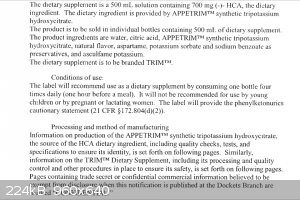Pasrules
Hazard to Self
 
Posts: 78
Registered: 4-1-2015
Location: Yellow Cake Deposit
Member Is Offline
Mood: Lacking an S orbital
|
|
Synthesis of Hydroxycitrate
I would like to synthesis hydroxycitrate from citric acid and have found nothing on a method to do so. My theory to produce this compound would be to
take citric acid and dehydrate the central tertiary alcohol using sulfuric acid forming a double bond (symmetrical so no problem there) then use an
oxidiser to introduce two Hydroxyl groups similar to producing a diol.
In stock I currently have food grade citric acid, 18M sulfuric acid which will be dilluted to 2M as per the recipe for aconitic acid and Potassium
Permanganate
This is for a food grade application.
Also here is a procedure to produce aconitic acid which would be step one of my process http://www.orgsyn.org/demo.aspx?prep=cv2p0012
[Edited on 5-1-2015 by Pasrules]
|
|
|
Bert
Super Administrator
        
Posts: 2821
Registered: 12-3-2004
Member Is Offline
Mood: " I think we are all going to die. I think that love is an illusion. We are flawed, my darling".
|
|
Looks like extraction from plant material (Garcinia, spp) is the main source?
Yes, looks like there's not much to be quickly found by Google on synthetic production-
http://www.fda.gov/ohrms/dockets/dockets/95s0316/95s-0316-rp...
 
Curious as to your intended use of this? Apparently this stuff is related to a crap ton of diet related spamvertising I encounter around the net!
Some information on traditional use, along with various studies
| Quote: |
Thus, what appears to be the most thorough study of hydroxycitrate obtained negative results. In addition, one other recent study (Rothacker et al.)
found results which were not statistically significant. The usefulness of this product remains to be demonstrated.
|
[Edited on 4-1-2015 by Bert]
Rapopart’s Rules for critical commentary:
1. Attempt to re-express your target’s position so clearly, vividly and fairly that your target says: “Thanks, I wish I’d thought of putting it
that way.”
2. List any points of agreement (especially if they are not matters of general or widespread agreement).
3. Mention anything you have learned from your target.
4. Only then are you permitted to say so much as a word of rebuttal or criticism.
Anatol Rapoport was a Russian-born American mathematical psychologist (1911-2007).
|
|
|
Pasrules
Hazard to Self
 
Posts: 78
Registered: 4-1-2015
Location: Yellow Cake Deposit
Member Is Offline
Mood: Lacking an S orbital
|
|
The apatite suppression is why the university is so crazy about it for money of course but why grow tropical fruit when instead you could grow lemons
and then just add a bit of oxidiser and catalyst.
Everything is so focused on the dieting factors that's it's impossible to find good synthesis papers that don't include the garcinia family.
My reason for making this is so I would have a positive control to test against once I have my fruit extract. Honestly I'm just going above and beyond
for a task to research analytical methods rather than applying them.
|
|
|
Bert
Super Administrator
        
Posts: 2821
Registered: 12-3-2004
Member Is Offline
Mood: " I think we are all going to die. I think that love is an illusion. We are flawed, my darling".
|
|
No need to grow lemons! Commercial critic acid is mostly made by a fermentation process, using moulds to process cheap sugar or starch byproducts.
http://patentimages.storage.googleapis.com/pdfs/US4994609.pd...
You're going to University in chemical engineering?
Rapopart’s Rules for critical commentary:
1. Attempt to re-express your target’s position so clearly, vividly and fairly that your target says: “Thanks, I wish I’d thought of putting it
that way.”
2. List any points of agreement (especially if they are not matters of general or widespread agreement).
3. Mention anything you have learned from your target.
4. Only then are you permitted to say so much as a word of rebuttal or criticism.
Anatol Rapoport was a Russian-born American mathematical psychologist (1911-2007).
|
|
|
Pasrules
Hazard to Self
 
Posts: 78
Registered: 4-1-2015
Location: Yellow Cake Deposit
Member Is Offline
Mood: Lacking an S orbital
|
|
I'm just starting second year in undergrad medical science so I've only completed introductory chemistry which was a joke. My chemistry background
came out of nowhere but luckily I have a job in food & pharma which gives me access to every chemical this forum could want, however I like the
humble approach of making it rather than buying it.
And the lemons was more of a joke on how expensive tropical fruits can be however thank you for the patent I can say I've learnt something.
|
|
|
Bert
Super Administrator
        
Posts: 2821
Registered: 12-3-2004
Member Is Offline
Mood: " I think we are all going to die. I think that love is an illusion. We are flawed, my darling".
|
|
Welcome to sciencemadness.org, please do take a couple of minutes and read the FAQ.
I'm going to leave this thread in organic chemistry, hoping to see your results if you do go "hands on" with this.
Rapopart’s Rules for critical commentary:
1. Attempt to re-express your target’s position so clearly, vividly and fairly that your target says: “Thanks, I wish I’d thought of putting it
that way.”
2. List any points of agreement (especially if they are not matters of general or widespread agreement).
3. Mention anything you have learned from your target.
4. Only then are you permitted to say so much as a word of rebuttal or criticism.
Anatol Rapoport was a Russian-born American mathematical psychologist (1911-2007).
|
|
|
Pasrules
Hazard to Self
 
Posts: 78
Registered: 4-1-2015
Location: Yellow Cake Deposit
Member Is Offline
Mood: Lacking an S orbital
|
|
Thank you for the warm welcome, I will make sure to do a proper write up when I do perform this experiment so it suits the organic chemistry thread.
|
|
|
deltaH
Dangerous source of unreferenced speculation
    
Posts: 1663
Registered: 30-9-2013
Location: South Africa
Member Is Offline
Mood: Heavily protonated
|
|
Another way to make vicinal diol's from alkenes is via the epoxide prepared from hydrogen peroxide and formic acid.
Attached, an illustrative example using cyclohexene.
Perhaps you won't even need formic acid since you already have aconitic acid as your substrate, in your specific case. The peroxide is also a
'cleaner' reagent.
Reference:
Roebuck, A & Adkins, H. (1948). trans-1,2-CYCLOHEXANEDIOL.Org. Synth. vol. 28. p35.
Attachment: trans-1,2-CYCLOHEXANEDIOL.pdf (294kB)
This file has been downloaded 498 times
[Edited on 5-1-2015 by deltaH]
|
|
|
Pasrules
Hazard to Self
 
Posts: 78
Registered: 4-1-2015
Location: Yellow Cake Deposit
Member Is Offline
Mood: Lacking an S orbital
|
|
Thankyou for the information on vicinal diols as i haven't heard of that term and it has given me a new key word to research.
I was also considering combining citric acid with an KMnO4 in the acidified medium then following the steps of extraction as per aconitic
acid. Would that be viable for a trial?
And you are already a step ahead of me, i will be using peroxide in my final run however the purple permanganate will act as an indicator until then.
|
|
|